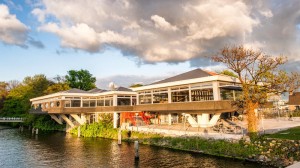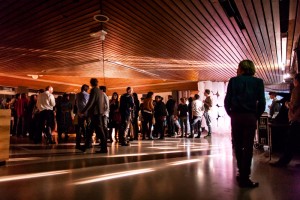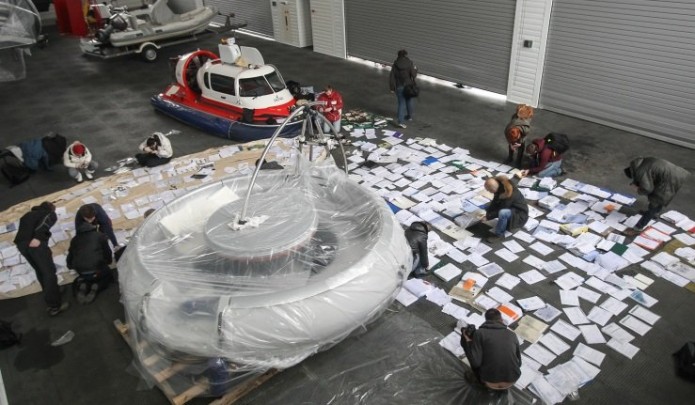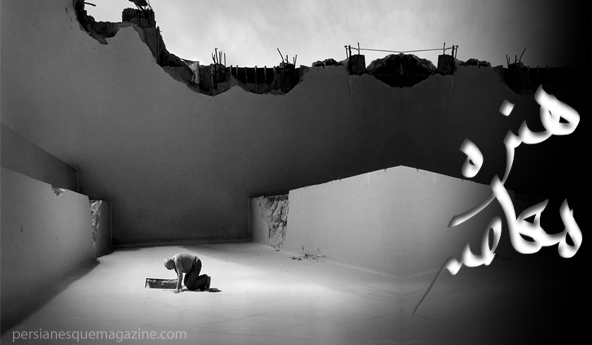
“It’s important to question the authority of institutions, to be self-reflective, to be open to criticism and adopt this in the artistic practice, to express multiple voices, and especially to acknowledge people’s different perspectives – and to incorporate this awareness into the stories you present. Bool: “It’s essential to realize knowledge always stems from a certain history, often from the Eurocentric history of science.”
Yasmijn Jarram talks with Josien Pieterse and Cas Bool of ‘Framer Framed’.
Framer Framed
“We shifted from reflection to presentation.”
After five years of leading a nomadic existence, Framer Framed has found a permanent home for hosting its regular discussions and debates at the Tolhuistuin in Amsterdam-North. As of May 2014 Framer Framed organizes international exhibitions in collaboration with guest curators.
 Tolhuistuin.
Tolhuistuin.
Framer Framed aims to advance knowledge and expertise regarding intercultural processes in contemporary art. Since 2009, they discuss the position of transcultural (‘non-western’) art in Dutch art institutions through public debates and expert meetings. Taking specific exhibitions as points of departure, members of the public are invited to share their views and opinions with the involved curators and museum directors. As the initiative’s name suggests, Framer Framed scrutinizes the ‘framer’ (the museum, the curator). Who does the framer represent? What assumptions are implied at the onset? Who is being included and who has been left out, and what are alternatives? In addition to offering critical analysis, new cultural strategies are being considered.
Josien Pieterse and Cas Bool talk about Framer Framed being founded in response to the ongoing public debate about the supposedly inward gaze of Dutch art museums. A new generation of curators wanted to open up the institute to fresh ideas. One of them was Meta Knol, curator at the Centraal Museum in Utrecht at the time. As she was working on Beyond the Dutch (2009), an extensive exhibition about the cross-pollination between Dutch and Indonesian artists, Knol found a lack of knowledge in the museum that prevented a valid interpretation of Indonesia’s modern art history. There was no syllabus of Indonesian artists to which to refer. According to Pieterse and Bool, this is still a problem: as opposed to art within a western frame of reference, art from different parts of the world doesn’t sit as comfortably in exhibitions without being articulated as such. This also influenced how art history was taught at Dutch universities: for example, chapters on Islamic architecture were casually left outside of the curriculum.
 Interior Tolhuistuin.
Interior Tolhuistuin.
Wim Manuhutu, director of the former Moluccan Historical Museum in Utrecht, faced some difficulties as well. Cas Bool: “This museum was a living monument for Moluccan culture, donated to the community by the government. The Moluccan history of migration was being told there, many historical photographs were on display. Wim Manuhutu wanted to update this, to include that modernity had also found its way into the Moluccas. It has its own development in contemporary art. However, the Moluccan community had different expectations. They wanted the museum to present them with a nostalgic view of their motherland.” Within the institutions, which are increasingly forced to shift focus towards generating revenue over innovation, it’s a rare individual who makes a difference, says Bool, who regrets the museum being closed. “Recent cutbacks have shown us where the government’s priorities lie. Many socially aware initiatives with innovative agendas have been eradicated. It reveals powerful financial currents which highlight certain stories over others. These are deliberate policies.”
In tune with the growing need for exchanging knowledge between contemporary art museums and ethnological museums, Framer Framed set out as a local initiative, but soon found itself operating on a national scale. The institutional frames had to be discussed, says Cas Bool. “They reflect a colonial worldview in which a division is made between ‘us’, Europe and Northern America; and ‘them’, meaning the rest of the world. The latter is left to be dealt with by ethnological museums, as they are the ones collecting material culture instead of contemporary art. This is a hierarchical judgment in itself: no art is being made ‘over there’.” With regards to managing collections, gradual changes were being made. Contemporary art museums tried to initiate dialogue with ethnographic institutions on interpreting and sharing its collections. Josien Pieterse: “Suddenly, this debate took off. The national demographic changed, people started to visit international exhibitions of more than just ‘western’ art, and also the art market evolved. Asian art became increasingly lucrative, and so the market forced the institutions into showing a different kind of art.”
 Archive ‘Unveiling the Present’.
Archive ‘Unveiling the Present’.
What causes Dutch museums to lag behind internationally on the matter of intercultural exchange? Cas Bool notes how there are several causes: “The way migration emerged, the way we treated our colonies, the ‘verzuiling’ (political and cultural segregation in The Netherlands, YJ), the social welfare state, the subsidy system… In the eighties, the Tropenmuseum in Amsterdam attempted to engage in a dialogue with contemporary art museums, which was met with little enthusiasm. The divide between art and heritage was probably not as wide in other countries. The critical evaluation of Dutch colonial heritage did not emerge until recently. There has never been a radical black movement in the Netherlands, at least not one of significant size.” Josien Pieterse refers to the well-known study by Dr. Philomena Essed from 1991 about everyday racism in the Netherlands. “For a long time, this topic was difficult to discuss in our country. The ongoing debate about Zwarte Piet demonstrates how these kinds of things don’t change overnight. This definitely has an influence as well; it’s not only a matter of policies.”
Framer Framed opened its new space at Tolhuistuin with ‘Crisis of History’, a group exhibition with young artists from the Middle East. The two previous shows by Framer Framed that were held on other locations, revolved around groups of artists from India and Iran. In an earlier article on AFRICANAH.ORG, Pauline Burmann, chairperson of the Thami Mnyele Foundation in Amsterdam, criticized the fact that Dutch art institutions often show ‘non-western’ art in a group context. How does Framer Framed feel about this? Josien Pieterse: “We are familiar with this criticism. However, we don’t intend to curate region-exhibitions all the time.” Cas Bool argues group exhibitions can indeed be interesting, because they allow for a diversity of voices to be expressed. “We don’t focus on the autonomy of an object, but on its social life; its relation to society. Our positions on this topic are not commonly shared in the hardcore white cube. If you were to organize a festival of Caribbean music, nobody would think anything of it. If you choose to focus on specific cultural aspects within the art context, you risk being chastised for selecting artists on their ethnical background instead of their individual strength.”
In recent years, Framer Framed has organized a great variety of open debates, public programs and discussions. Have they come any closer to finding an ideal template for so-called ‘post-colonial’ exhibition making? Cas Bool explains there’s no one specific formula, however several aspects are to be considered. It’s important to question the authority of institutions, to be self-reflective, to be open to criticism and adopt this in the artistic practice, to express multiple voices, and especially to acknowledge people’s different perspectives – and to incorporate this awareness into the stories you present. Bool: “It’s essential to realize knowledge always stems from a certain history, often from the Eurocentric history of science.” Inviting external experts can add great value to the process.
 Image from ‘Contempoary Art Forum Iran’
Image from ‘Contempoary Art Forum Iran’
Framer Framed’s upcoming exhibition at Tolhuistuin is ‘Costume Bureau’, named after a key work by Mark Dion (US, 1961). The show will be put together by Roel Arkesteijn, curator of museum Het Domein in Sittard. In Amsterdam, several works from the museum’s collection will be displayed. Bool and Pieterse praise Arkesteijn on his refreshing way of collecting: “Many museums are only interested in expanding their existing collections, by which they risk reinforcing the old dichotomy. Roel Arkesteijn prefers to show that which has not been shown in Dutch museums before. He also collects many artists who reflect on institutional critique.” To Het Domein, it’s important to show their collection outside of the province of Limburg, while Framer Framed is excited to work with a museum. It’s one of many ambitious projects coming up at Tolhuistuin. Pieterse: “We shifted from reflection to presentation. We will reinvent ourselves here.”
The exhibition ‘Costume Bureau’ runs from October 10 to November 24 2014.
